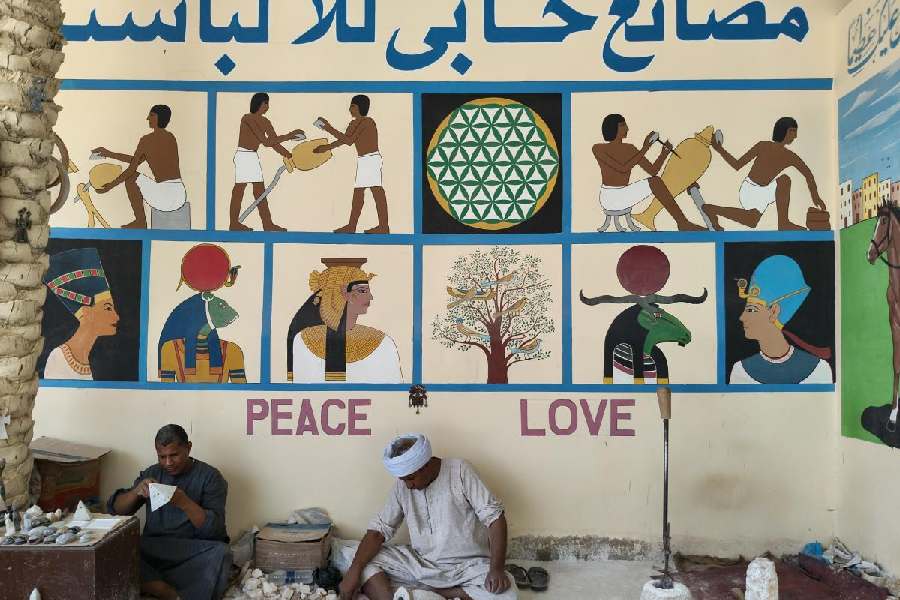The tryst with Tut begins in Cairo. King Tut is how the boy king — Tutankhamun of the Eighteenth Dynasty of Ancient Egypt — is referred to.
In the Egyptian Museum in Cairo, a separate gallery is dedicated to the king and his riches. The gallery holds so much gold that photography is prohibited.
A walkaround and one is immediately gasping over the elaborate gold neckpieces, the winged scarab necklace, the gold ring bearing the throne name of Tutankhamun, the solid gold mask. We — my husband and I — are told by one of the museum keepers, that soon all of Tutankhamun’s exhibits will shift to the Great Egyptian Museum, near the valley of Giza.
King Tut’s tomb is in Luxor. The plaque reads: “The tomb of Tut Ankh Amun, No 62 (sic).”
There are stories, hearsay, and conjectures many about one of the most famous archaeological discoveries of the 20th century. However, one story about a water boy discovering the steps to the historic tomb does the rounds of the Valley of Kings more than any other.
“The tomb was actually discovered by an Egyptian boy,” said our guide Ahmad Samir. The hot August sun bore down and glinted off the neighbouring stone quarries, as he told his story. “The boy was employed by the archaeologists’ team to carry water. It was his donkey whose hooves struck the tomb leading the boy to the discovery.” When we queued up to enter the famous tomb, he added, “The other tombs are more elaborate. Tut’s tomb is modest by comparison.”
The water boy story gains credence from the lone black and white photograph of 1922/23 vintage — a 12-year-old boy in robes wearing an elaborate necklace. “He was rewarded by Carter who allowed him to wear Tutankhamun’s necklace,” said our guide. British archaeologist Howard Carter was the one who discovered King Tut’s tomb in 1922.
Later, at the Theban village of Gurna where alabaster factories abound, he took us to a curio shop, named Hapi after the god of the Nile. And this is where we met the man who claims he is the descendant of the water boy.
A handful of workers sat in the shade in front of the curio shop, polishing stones. Shop owner Mohammed Abdelrasul greeted us. He showed us how uneven granite and limestone are cut, shaped and polished before they are carved. Inside Hapi, a well-appointed, air-conditioned showroom, Abdelrasul told us the story of his famed ancestor.
“The boy was Sheikh Hussain Ali Abdelrasul, my great, great grandfather. His ear caught the hollow sound his donkey’s hooves made against the ground and he knew something lay below,” said Mohammed.
The Abdelrasul family has for nine generations been tomb diggers. In fact, three brothers of the family were detained and tortured by the ministry of antiquities in 1872 for having raided the royal tombs on the rocky mountain of Deir el-Bahari. As the story goes, a goat had fallen into a crevice and one of the brothers was trying to rescue the goat when he came across a royal tomb and raided it.
It is usual for the villagers of Gurna to stumble upon such tombs and burial chambers as they inhabit the area. Several attempts to rehabilitate them elsewhere by the ministry have failed. “Every morning I send my workmen to gather stones from the surrounding quarries. They get the best quality alabaster from the surrounding hills. We know this area like the back of our palms. Even today, we are approached by the ministry for assistance in locating tombs,” said Mohammed.
The ministry of antiquities of the Egyptian government apparently relies on three families living in the area when it comes to locating tombs. “We recently discovered 50 mummies here,” he added.
“It is a terrain that hides many things. And over the years, decades, centuries, things get buried deep. And while we dig for good quality alabaster, we come across a lot of things. Small figures, bric-a-bracs of olden times,” he said smiling conspiratorially. Do they choose to keep their finds, probably waiting for a wealthy customer? “No,” Mohammed denied vehemently. “We keep them safe and secure for they are the goods of the dead.”











